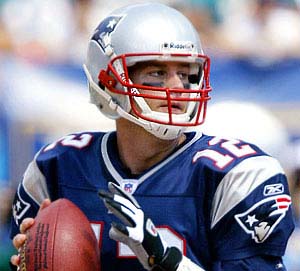New Injury Listed for Tom Brady

New England Patriots’ quarterback Tom Brady has missed the last two practices with the team. In last week’s loss to the Miami Dolphins, Brady had been nursing an injured thumb, but now the team’s participation list also reports a rib injury. Brady had received a pretty hard hit during a 58 yard touchdown pass to receiver Randy Moss in the first quarter of the Dolphins game, and retreated to the locker room for a short period of time.
A Short Anatomy Lesson about Ribs:
There are twelve pairs of ribs, connecting to the spine in the back, and by cartilage extensions (called the costal cartilages) to the breastbone (sternum) in the front. This space is called the thoracic cage. The ribcage has two main functions-the first being protection of the delicate vital organs within it - the heart and lungs.
The second is its participation in the process of breathing. Between each rib is a muscle called an intercostal muscle. Across the floor of the ribcage is the large muscular diaphragm. During an inspiration, the diaphragm contracts and flattens, and the intercostal muscles contract, pulling the ribs up and out. This action causes a partial vacuum within the thoracic cage, which pulls air into the lungs. On expiration, the muscles relax, and air is expelled from the lungs.
Blunt force is the primary cause of rib injuries, such as occurs in sports, motor vehicle accidents, or crush injuries to the chest. Injuries can occur to the soft tissues, or to the ribs themselves:
Soft tissue injuries
Soft tissue of the ribcage includes the intercostal muscles and the costal cartilage. Common injuries include:
- Bruising – the blood vessels rupture and leak blood into the surrounding tissues. Bruising of the chest wall is a common rib trauma.
- Intercostal strains – intercostal muscles allow the ribcage to move up and down. These muscles can be strained by any activity that involves extreme or forceful twisting of the body or swinging of the arms. Sports that commonly cause this type of injury include golf and tennis.
- Costochondral separation – the rib is torn loose from the costal cartilage and is detached from the sternum.
Rib fracture
The curved design of the ribs makes them resistant to fractures. Their ability to flex helps the bone to absorb the force of a blow. However,any bone will break if the force exerted against it is stronger than it can structurally withstand. A rib is most likely to fracture at its outer curve, which is its weakest point.
The symptoms of rib injuries depend on the type and severity of the injury, but can include:
- Pain at the injury site
- Pain when the ribcage flexes – with movement, with a deep breath or when you cough, sneeze or laugh
- Crunching or grinding sounds (crepitus) when the injury site is touched or moved
- Muscle spasms of the ribcage
- Deformed appearance of the ribcage
- Breathing difficulties.
























0 comments